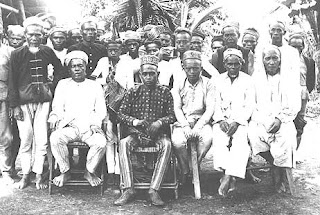 Bud Dajo Bud (Mt.) Dajo is a lava cone of an extinct volcano at an altitude of 2100 feet six miles east of Jolo. The crater in the summit has a circumference of 1800 yards.
Bud Dajo Bud (Mt.) Dajo is a lava cone of an extinct volcano at an altitude of 2100 feet six miles east of Jolo. The crater in the summit has a circumference of 1800 yards.In 1906, the Taosugs were quite disenchanted with their Sultan and prominent datus. They hated the Americans and their man-made laws. When the US military patrols come to collect tax, they ran for cover.
Bud (Mt.) Dajo is a lava cone of an extinct volcano at an altitude of 2100 feet. The crater in the summit has a circumference of 1800 yards. The crater was a natural fortress; hence, a favorite shelter or hide-away for Moro "tax evaders", who were mostly poor people. Soon families were staying in the crater.
 By March 1906, more than a thousand Moros -- men, women and children, made their way to the crater. Gen. Wood would not have any of their nonsense. He ordered his officers to gather in Jolo. Col. Duncan with about 800 officers and men from the 6th and 19th infantry, the 4th Cavalry, the 28th Artillery Battery, the Sulu Constabulary and sailors from the gunboat Pampanga, with mountain guns, rifles, bayonets, fast-firing pistols and grenades launched the assault on March 5.
By March 1906, more than a thousand Moros -- men, women and children, made their way to the crater. Gen. Wood would not have any of their nonsense. He ordered his officers to gather in Jolo. Col. Duncan with about 800 officers and men from the 6th and 19th infantry, the 4th Cavalry, the 28th Artillery Battery, the Sulu Constabulary and sailors from the gunboat Pampanga, with mountain guns, rifles, bayonets, fast-firing pistols and grenades launched the assault on March 5. The thousand or so Moro men, women and children were armed with kris, barungs and spears. By March 7, the smoke of battle has cleared. The people in the crater fought bravely, to the last Moro. There were no survivors. The Americans lost two dozen men and some seventy wounded. It was a complete massacre.
Gen. Wood reported to the Secretary of War the success of his mission -- the Moros losing 600 men, women and children while the US lost only 18 men and 52 wounded. President Roosevelt immediately sent a note to Wood: "I congratulate you and the officers and men of your command upon the brave feat of arms wherein you and they so well upheld the honor of the American flag." 

But there were protests. The New Orleans Times-Democrat called the event "a frightful atrocity". The Boston Post exclaimed: "..if this is imperial expansion….heaven save us from anymore!" The Democrats called the affair a "horrible massacre" and "an assassination."
Vic Hurley, an American who stayed in Mindanao for seven years and wrote a book on the Moros in 1936(5), tells a more detailed account of the encounter, apparently based on "acquaintances of elders of many Moro barrios" and various histories of the Philippines then extant. He writes:
A large band of Moros fortified Bud Dajo and defied the authorities to subject them to any law. The American garrison at Jolo was reinforced by the addition of two battalions of infantry and preparations were made for a decisive assault on the Moros.
The battle began on March 5. Mountain guns were hauled into position and forty rounds of shrapnel were fired into the crater to warn the Moros to remove their women and children.(7)
Three columns of American troops moved up Bud Dajo from different sides and encountered fierce resistance from barricades blocking the approach to the crater. When overwhelmed with heavy bombardment and sniper fire, the Moros "sallied forth into the open with kris(8) and spear."
Three columns of American troops moved up Bud Dajo from different sides and encountered fierce resistance from barricades blocking the approach to the crater. When overwhelmed with heavy bombardment and sniper fire, the Moros "sallied forth into the open with kris(8) and spear."
On the second day, in the approach taken by a certain Major Bundy, "(t)wo hundred Mohammedans died here before the quick-firing guns and the rifles of the attackers."
On the third day, After the heavy bombardment had accomplished its purpose, the American troops charged the crater with fixed bayonets. The few Moros left alive made hand grenades from sea shells filled with black powder and fought desperately to stem the charge. But the straggling krismen were no match for the tide of bayonets that overwhelmed them and hardly a man survived that last bloody assault.

After the engagement the crater was a shambles. Moros were piled five deep in the trenches where they had been mowed down by the artillery and rifle fire. The American attack had been supported by two quick firing guns from the gunboat Pampanga and examination of the dead showed that many of the Moros had as many as fifty wounds. Of the 1,000 Moros who opened the battle two days previously, only six men survived the carnage.
Hurley's judgement of the event is significant. He states: By no stretch of the imagination could Bud Dajo be termed a "battle." Certainly the engaging of 1000 Moros armed with krises, spears and a few rifles by a force of 800 Americans armed with every modern weapon was not a matter for publicity. The American troops stormed a high mountain peak crowned by fortifications to kill 1000 Moros with a loss to themselves of twenty one killed and seventy three wounded!
The casualty reflects the unequal nature of the battle. The Moros had broken the law and some punishment was necessary if America was to maintain her prestige in the East, but opinion is overwhelming in the belief that there was unnecessary bloodshed at Bud Dajo.
Links :






No comments:
Post a Comment